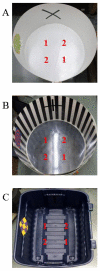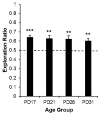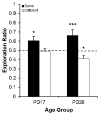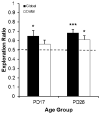Ontogeny of object-in-context recognition in the rat
- PMID: 25892362
- PMCID: PMC4732722
- DOI: 10.1016/j.bbr.2015.04.011
Ontogeny of object-in-context recognition in the rat
Abstract
The object-in-context recognition (OiC) task [19] is a spontaneous exploration task that serves as an index of incidental contextual learning and memory. During the test phase, rats prefer to explore the object mismatched to the testing context based on previous object-context pairings experienced during training. The mechanisms of OiC memory have been explored in adult rats [12,35]; however, little is known about its determinants during development. Thus, the present study examined the ontogeny of the OiC task in preweanling through adolescent rats. We demonstrate that postnatal day (PD) 17, 21, 26, and 31 rats can perform the OiC task (Experiment 1) and that preference for the novel target is eliminated when rats are tested in an alternate context not encountered during training (Experiment 2). Lastly, we show that PD26 but not PD17 rats can perform the OiC task when the training contexts only differed by distal spatial cues (Experiment 3). These data demonstrate for the first time that PD17 rats can acquire and retain short-term OiC memory, which involves associative learning of object and context information. However, we also provide evidence that preweanling rats' ability to utilize certain aspects of a context (i.e., distal spatial cues) in the OiC task is not equivalent to that of their older counterparts. Implications for the development of contextual memory and its related neural substrates are discussed.
Keywords: Context; Hippocampus; Incidental learning; Long–Evans rat; Ontogeny; Short-term memory.
Copyright © 2015 Elsevier B.V. All rights reserved.
Figures









Similar articles
-
Determinants of object-in-context and object-place-context recognition in the developing rat.Dev Psychobiol. 2016 Nov;58(7):883-895. doi: 10.1002/dev.21432. Dev Psychobiol. 2016. PMID: 27753457
-
Infant rats can acquire, but not retain contextual associations in object-in-context and contextual fear conditioning paradigms.Dev Psychobiol. 2020 Dec;62(8):1158-1164. doi: 10.1002/dev.21980. Epub 2020 May 22. Dev Psychobiol. 2020. PMID: 32441808
-
Ontogeny of object versus location recognition in the rat: acquisition and retention effects.Dev Psychobiol. 2014 Nov;56(7):1492-506. doi: 10.1002/dev.21232. Epub 2014 Jul 3. Dev Psychobiol. 2014. PMID: 24992011 Free PMC article.
-
One-trial object recognition in rats and mice: methodological and theoretical issues.Behav Brain Res. 2010 Dec 31;215(2):244-54. doi: 10.1016/j.bbr.2009.12.036. Epub 2010 Jan 7. Behav Brain Res. 2010. PMID: 20060020 Review.
-
The rodent object-in-context task: A systematic review and meta-analysis of important variables.PLoS One. 2021 Jul 16;16(7):e0249102. doi: 10.1371/journal.pone.0249102. eCollection 2021. PLoS One. 2021. PMID: 34270575 Free PMC article.
Cited by
-
Developmental trajectory of episodic-like memory in rats.Front Behav Neurosci. 2022 Nov 29;16:969871. doi: 10.3389/fnbeh.2022.969871. eCollection 2022. Front Behav Neurosci. 2022. PMID: 36523755 Free PMC article.
-
Phenotypic outcomes in adolescence and adulthood in the scarcity-adversity model of low nesting resources outside the home cage.Dev Psychobiol. 2017 Sep;59(6):703-714. doi: 10.1002/dev.21547. Epub 2017 Aug 2. Dev Psychobiol. 2017. PMID: 28767135 Free PMC article.
-
Extended access self-administration of methamphetamine is associated with age- and sex-dependent differences in drug taking behavior and recognition memory in rats.Behav Brain Res. 2020 Jul 15;390:112659. doi: 10.1016/j.bbr.2020.112659. Epub 2020 May 8. Behav Brain Res. 2020. PMID: 32437887 Free PMC article.
-
Hippocampal gamma rhythms during Y-maze navigation in the juvenile rat.Hippocampus. 2020 May;30(5):505-525. doi: 10.1002/hipo.23168. Epub 2019 Oct 18. Hippocampus. 2020. PMID: 31626396 Free PMC article.
-
Postnatal development of the relaxin-3 innervation of the rat medial septum.Front Neurosci. 2023 May 10;17:1176587. doi: 10.3389/fnins.2023.1176587. eCollection 2023. Front Neurosci. 2023. PMID: 37234259 Free PMC article.
References
-
- Rudy JW. Contextual conditioning and auditory cue conditioning dissociate during development. Behavioral Neuroscience. 1993;107(5):887–891. - PubMed
-
- Phillips RG, LeDoux JE. Differential contribution of amygdala and hippocampus to cued and contextual fear conditioning. Behavioral Neuroscience. 1992;106(2):274–285. - PubMed
-
- Fanselow MS. Contextual fear, gestalt memories, and the hippocampus. Behavioural Brain Research. 2000;110(1-2):73–81. doi:S0166432899001862 [doi] - PubMed
Publication types
MeSH terms
Grants and funding
LinkOut - more resources
Full Text Sources
Other Literature Sources
Medical

